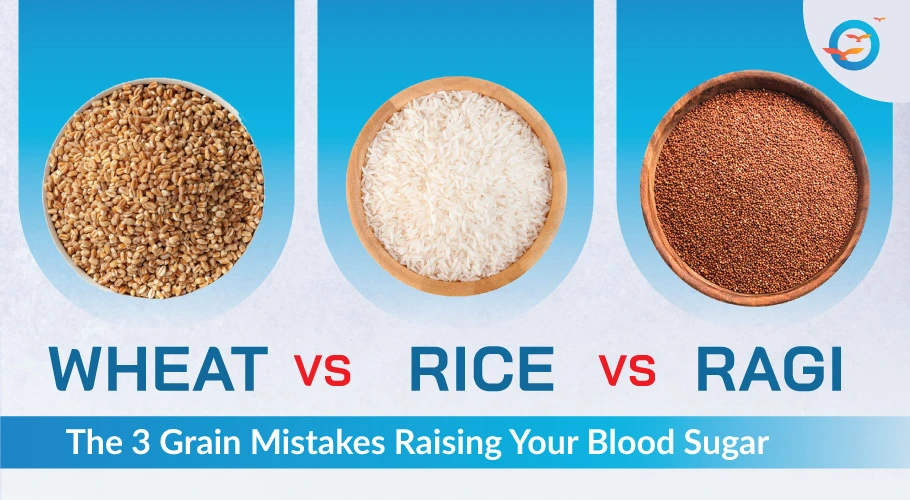Wheat vs Rice vs Ragi: The 3 Grain Mistakes Raising Your Blood Sugar

Many people assume that simply switching to “healthier grains” is enough to control blood sugar and lose weight. Unfortunately, this is one of the biggest misconceptions in nutrition. Certain grains often marketed as wholesome or traditional can sharply raise blood glucose, increase cravings, and even slow down weight loss.
Understanding how grains behave in the body, especially the connection between wheat and diabetes, glycemic index, and portion size, can help prevent these hidden metabolic setbacks.
Below are the three most common grain traps that people fall into and what to choose instead.
Why Grains Matter So Much in Diabetes and Weight Loss?
Grains directly influence blood glucose through two mechanisms:
- Glycemic Index (GI)
How quickly a grain raises your sugar.
- Glycemic Load (GL)
How much total sugar a grain delivers based on portion size.
This is why comparing the glycemic index of wheat vs rice becomes important. Some grains digest extremely fast, causing a rapid spike in glucose and insulin. Others carry a high glycemic load because they are eaten in larger quantities, making them unsuitable as daily blood sugar control foods.
Not all grains behave the same, and these differences matter for diabetics, prediabetics, and anyone trying to manage weight.
Grain Trap 1: Is Ragi Really Better Than Wheat or Rice?
Ragi is often seen as a superior replacement to wheat or rice. But its impact on blood sugar tells a very different story.
Actual Glycemic Index of Ragi:
- Ragi porridge / ragi dosa (finely ground): ~85
- Ragi roti: ~75
- Ragi mudde: ~65
This means ragi digests extremely fast faster than many types of white rice.
People across Bengaluru, Chennai, Coimbatore and other regions have reported worsening HbA1c, neuropathy symptoms, and poor sugar control after increasing ragi consumption.
For those looking for grains to avoid for weight loss, ragi can also be challenging because quick spikes often lead to more cravings.
So, is ragi better than wheat? Not for sugar or weight control.
Grain Trap 2: Are Jowar Rotis Always a Healthier Choice?
Jowar is marketed as a “good carb,” but that is only partially true.
Key facts:
- Jowar GI: ~70, higher than wheat and brown rice
- Jowar rotis are heavier:
- 2 wheat fulkas ≈ 60 g
- 2 jowar rotis ≈ 90–100 g
This higher weight increases the glycemic load, causing larger glucose spikes.
So while someone may ask, does wheat increase blood sugar, the better question is whether heavy jowar rotis spike sugar more and often, the answer is yes.
A practical solution is mixing: ¼ urad dal + ¾ jowar flour, which reduces the GI but doesn’t make it ideal for daily diabetic use.
Grain Trap 3: Is Wheat Always Better Than Rice?
The wheat-versus-rice debate often confuses people, but the answer lies in the type of wheat used.
Safer Wheat Varieties
- Emmer/Khapli/Jungli/Lal Gehun(Red Wheat)
GI: 45–55
– Lower gluten
– Slower absorption
– Better for those asking, “can diabetics eat wheat?”
Regular Wheat
Higher GI, higher gluten, and more insulin stimulation. When comparing glycemic index wheat vs rice, regular wheat actually performs worse than brown rice.
Rice
- White sticky rice: GI 70–90 (very high)
- Shorter, stickier grains: spike sugar the most
- Long-grain basmati: lower GI due to less stickiness
So the question “which rice is good for diabetic person?” has a clear answer: Controlled portions of long-grain basmati are the safer choice.
Better Grain Choices for Diabetes & Weight Loss
Safer Options
- Emmer/Khapli wheat
- Rajgira (amaranth)
- Wheat-dal blended flours
- Controlled portions of long-grain basmati rice
These work well as alternatives of wheat flour for diabetics and help stabilize post-meal sugars.
Grains to Limit or Avoid
- Ragi (finely ground forms especially)
- Regular wheat
- Heavy jowar rotis
- Sticky white rice
Choosing lower-GI, lower-GL grains keeps insulin steadier and supports long-term metabolic health.
Conclusion
Grains are not inherently harmful but the wrong ones can dramatically affect blood sugar, weight, and cravings.
Understanding the real impact of wheat and diabetes, choosing lower-GI grains, and avoiding high-load rotis can prevent sugar spikes and support weight management. Small shifts in grain choices create powerful, long-term improvements in metabolic health.
Want to know why sugar cravings hit right after eating & how to fix it? Visit our blog.
FAQs
1. What grains should diabetics avoid?
Ragi, regular wheat, sticky white rice, and heavy jowar rotis due to high GI and glycemic load.
2. Which grains should I avoid for weight loss?
Ragi, regular wheat, and large jowar rotis should be minimized.
4. Which grain is good for a diabetic person?
Emmer/Khapli wheat, rajgira, and limited portions of long-grain basmati rice.
5. Which rice is good for a diabetic person?
Long-grain basmati rice, due to its lower stickiness and moderate GI.
6. Which is better for diabetics — wheat or ragi?
Emmer/Khapli wheat is safer; ragi has a much higher GI.
7. Ragi or wheat — which is better for weight loss?
Emmer wheat supports better weight control than ragi.
8. Is ragi better than wheat?
No. Ragi’s GI is much higher than both wheat and rice.
9. Which is better, chapati or ragi?
Chapati made from emmer/khapli wheat is better for sugar control than ragi.
